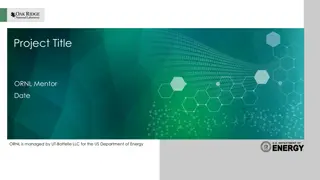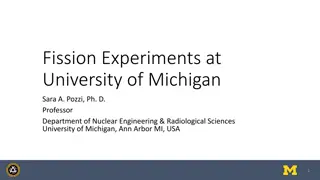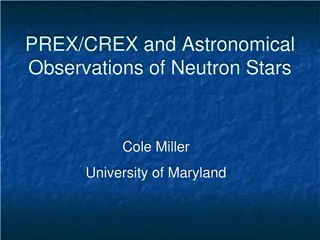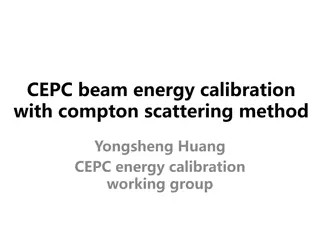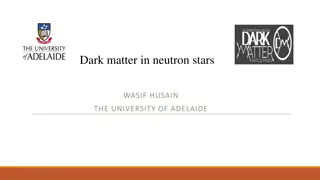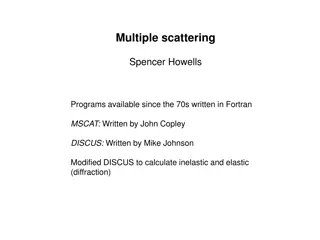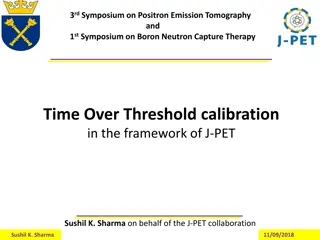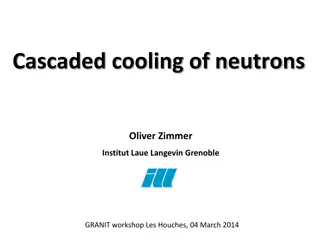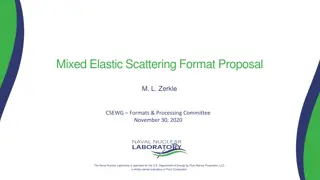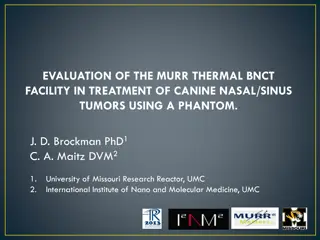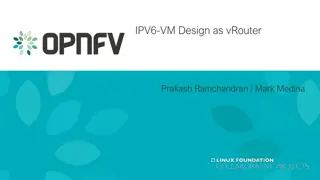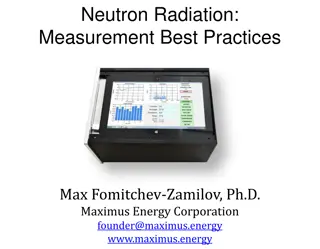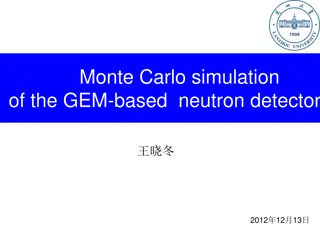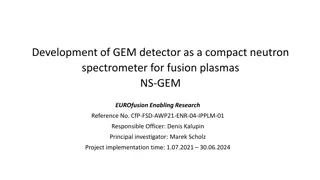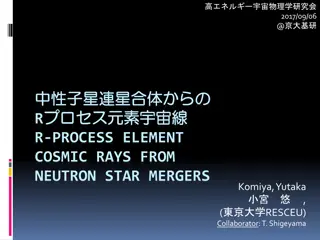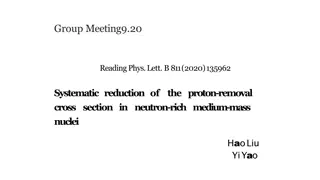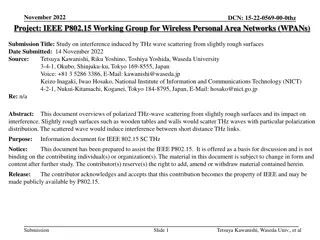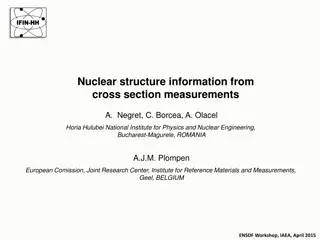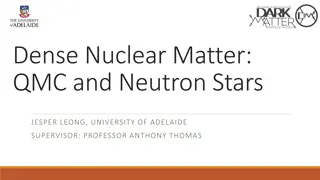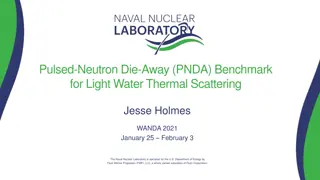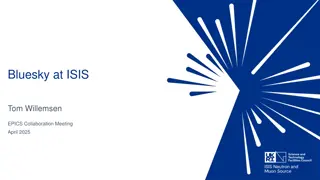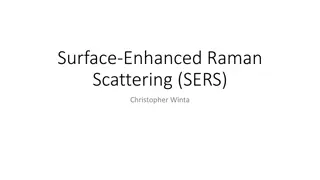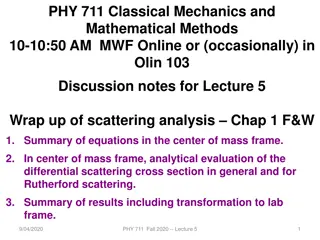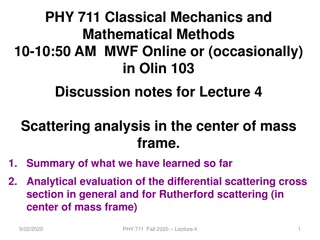European Spallation Source Neutron Instrument Project Overview
The European Spallation Source (ESS) Neutron Instrument Project aims to develop 15 world-leading neutron instruments by 2023. The project involves instrument classes, performance targets, budget considerations, and a planned schedule for instrument commencement. The NSS project scope includes reduci
9 views • 18 slides
Neutron Stars: Discoveries and Characteristics
Neutron stars, initially proposed in 1933, have been the subject of various discoveries and studies. They are characterized by their unique properties such as compactness, high density, rapid spinning, and strong magnetic fields. Neutron stars are predominantly composed of neutrons, with other parti
4 views • 23 slides
Advanced Neutron Scattering Research Project at ORNL
This project proposal outlines a research opportunity at Oak Ridge National Laboratory (ORNL) focusing on forefront scientific problems and the strategic value of neutron scattering techniques. Graduate students will benefit from valuable experience and collaboration opportunities during their time
2 views • 5 slides
Neutron Multiplicity Measurement in Muon Capture on Oxygen in Super-Kamiokande
Explore the neutron multiplicity measurement in muon capture on oxygen using Super-Kamiokande, a water-Cherenkov detector located underground in Japan. Gadolinium was added to enhance neutron tagging efficiency, aiding in Supernova observation, proton decay rejection, and more. Neutron signals are t
3 views • 16 slides
Advanced Fission Experiments at University of Michigan
The University of Michigan, under the guidance of Dr. Sara A. Pozzi, conducts cutting-edge fission experiments leveraging organic scintillation detectors. These detectors offer advantages such as nanosecond-scale response times, energy proportionality, and scalability. The experiments focus on impro
0 views • 4 slides
Insights into Neutron Stars: Observations and Implications
Exploring the fascinating realm of neutron stars through astronomical observations and the implications for equations of state (EOS). Delve into the mysteries of neutron star properties, measurement results from projects like PREX/CREX, and the significance of NS masses, tidal deformabilities, and r
1 views • 24 slides
Beam Energy Calibration with Compton Scattering Method
The CEPC beam energy calibration with Compton scattering method led by Yongsheng Huang and the CEPC energy calibration working group involves collaborations with various institutions and organizations. The project includes detailed physics requirements, system designs, and implementation plans for b
2 views • 14 slides
Dark Matter in Neutron Stars
Investigate the interaction of dark matter within neutron stars, comprising approximately 25% of the universe's total matter. The nature of dark matter assumptions, its distribution within neutron stars based on fermionic or bosonic properties, and the implications for self-interacting fermionic and
1 views • 22 slides
Multiple Scattering Programs in Fortran for Neutron Diffraction and Inelastic Analysis
Multiple scattering programs like MSCAT and DISCUS, written in Fortran since the 70s, are essential tools for neutron diffraction and inelastic analysis. These programs allow for the calculation of neutron cross-sections, scattering angles, and sample geometries. The results obtained include elastic
4 views • 8 slides
Semiconductor Conductivity and Scattering Mechanisms
In the study of semiconductor conductivity, the concept of degenerate and non-degenerate semiconductors is discussed, showcasing the impact of doping levels. The conductivity equation is explored in terms of electron and hole mobilities and densities. The role of scattering mechanisms, such as latti
5 views • 18 slides
Symposium on Positron Emission Tomography and Boron Neutron Capture Therapy Time-Over-Threshold Calibration in J-PET
The 3rd Symposium on Positron Emission Tomography and 1st Symposium on Boron Neutron Capture Therapy focused on Time-Over-Threshold calibration within the framework of J-PET. The event outlined experimental details, event selection, results, and key features of the Jagiellonian Positron Emission Tom
2 views • 35 slides
Advancements in Neutron Cooling Techniques and Paramagnetic Systems
The presentation discusses cascaded cooling of neutrons and Namiot's proposal for phononless cooling to low temperatures using polarized deuterons. It explores inelastic scattering cross-sections, candidate paramagnetic systems, and excitations in O2. Additionally, it covers rate constants, superflu
4 views • 11 slides
Mixed Elastic Scattering Format Proposal
This proposal focuses on introducing a Mixed Elastic Scattering format to address the need for a more rigorous treatment of thermal elastic scattering effects in selected nuclides. The format extension, compatible with ENDF-6, supports advanced moderator development without impacting existing TSL ev
2 views • 6 slides
Evaluation of MURR Thermal BNCT Facility for Canine Nasal/Sinus Tumor Treatment
The study evaluates the MURR Thermal BNCT Facility's effectiveness in treating canine nasal/sinus tumors using a phantom. The facility, located at the University of Missouri Research Reactor, offers Boron Neutron Capture Therapy (BNCT) under the direction of Dr. Fred Hawthorne. Key features include
0 views • 21 slides
Overview of vRouter Implementation in Openstack Neutron
Virtual router (vRouter) is a crucial component in network virtualization, with applications in cloud environments like Openstack Neutron. This article delves into the concept of vRouter, its importance in IPv6 implementations, and the utilization of VM-based vRouters. It also explores the current s
2 views • 12 slides
Neutron Radiation Measurement Guidelines and Techniques
Understanding neutron detection basics, absorption cross-section, moderators, positioning, and common detector types is crucial for accurate measurements. Neutrons vary in energy levels, requiring specific detection techniques. Thermal neutrons are easier to detect than fast ones, with materials lik
4 views • 34 slides
Monte Carlo Simulation of GEM-Based Neutron Detector and Detector Performance Analysis
A detailed exploration of Monte Carlo simulations for GEM-based neutron detectors, investigating their detection efficiency and performance characteristics. Various detector designs and concepts, including multi-layer converters and GEM detectors, are discussed, along with simulation results on sign
3 views • 12 slides
Development of NS-GEM Neutron Spectrometer for Fusion Plasmas
This project focuses on developing a compact neutron spectrometer, NS-GEM, using gas electron multiplier detector technology for fusion plasma applications. The goal is to achieve high energy resolution, low sensitivity to γ-rays, and high count rate capabilities for accurate neutron measurements.
0 views • 22 slides
Neutron Star Mergers and Ultra Heavy Element Cosmic Rays: Exploring Their Connection
Delve into the intriguing link between neutron star mergers and the synthesis of ultra heavy element cosmic rays. The rapid neutron capture process, known as r-process, plays a crucial role in creating elements heavier than iron through events like neutron star mergers and core-collapse supernovae.
1 views • 19 slides
Recent Advancements in Neutron Standards Evaluation
Recent work by Allan D. Carlson, a NIST associate under contract with BNL, was presented at the CSEWG meeting discussing possible changes to neutron standards and showcasing important measurements, such as H(n,n)H angular distribution data by Jiang et al. and 6Li(n,t) reaction measurements by Bai et
1 views • 15 slides
Systematic Reduction of Proton-Removal Cross Section in Neutron-Rich Medium-Mass Nuclei
Single-nucleon knock-out reactions in neutron-rich medium-mass nuclei were studied to investigate the reduction of proton-removal cross section. Short-range correlated nucleon pairs, especially protons, were found to impact the probability of single-proton removal processes. Experimental measurement
0 views • 8 slides
Study on THz Wave Scattering from Slightly Rough Surfaces: Interference and Implications
Overview of polarized THz wave scattering from slightly rough surfaces such as wooden tables and walls. The document discusses the induced interference between short-distance THz links and presents a model of electromagnetic wave scattering with examples of experimental and numerical results. Potent
1 views • 17 slides
Nuclear Structure Information from Cross Section Measurements
This study presents findings on nuclear structure information obtained from cross section measurements conducted by A. Negret, C. Borcea, and A. Olacel at Horia Hulubei National Institute for Physics and Nuclear Engineering in Romania. The measurements include neutron inelastic cross section studies
0 views • 20 slides
Isotope Effects in Thermal Neutron Scattering
This research discusses isotope effects in thermal neutron scattering, presented at the ORNL Cross Section Evaluation Working Group Meeting in November 2021. The study explores the impact of different isotopes on neutron scattering behavior, shedding light on valuable insights for neutron scattering
0 views • 10 slides
Exploring Quark-Meson-Coupling in Dense Nuclear Matter and Neutron Stars
Delve into the realm of dense nuclear matter and neutron stars with a focus on the Quark-Meson-Coupling theory. Discover the significance of neutron stars in constraining the Equation of State and the interplay between different nuclear theories. Uncover insights into heavy neutron stars, the Hypero
1 views • 16 slides
Enhancements for ENDF/B-IX Thermal Neutron Scattering
Explore the discussion topics and evaluations presented in the Mini-CSEWG Meeting for targeted strategic investments to prepare for ENDF/B-IX TSL validation. The session covers new/revised TSL evaluations, alternate enrichment treatments, and the need for thermal scattering laws for various fuel com
2 views • 9 slides
Quantum Mechanics Lecture on Scattering Theory and Cross Section Analysis
Explore the concepts of scattering theory, phase shifts, optical theorem, and Born approximation in quantum mechanics. Understand the differential scattering cross-section and probability of particle scattering through spherically symmetric interaction potentials.
0 views • 18 slides
Light Scattering in Polymer Characterization
Explore the principles of light scattering for polymer characterization, including static and dynamic forms, elastic and inelastic scattering, and measurement schemes. Learn how light scattering determines polymer size, distribution, and molecular weight in solution, aiding in intricate analyses of
2 views • 26 slides
Pulsed-Neutron Die-Away (PNDA) Benchmark for Light Water Thermal Scattering
Explore the Pulsed-Neutron Die-Away (PNDA) benchmark experiment involving the interaction of 14 MeV neutrons with water, providing insights into thermal and spatial equilibrium, neutron flux behavior, and sensitivity to scattering properties. Discover how this experiment offers a cost-effective appr
3 views • 4 slides
Electromagnetic Scattering Multipole Analysis and Coefficients
Explore the concept of multipole analysis in electromagnetic scattering, including multipole expansion, coefficients, Mie scattering, COMSOL implementation, and associated Legendre polynomials. Learn how to extract crucial information from scattering models and optimize simulations efficiently.
3 views • 24 slides
Naval Nuclear Laboratory Special Purposes: O-17, O-18, Be-9 Evaluations
The Naval Nuclear Laboratory specializes in special purpose evaluations involving O-17, O-18, and Be-9. The evaluations focus on neutron production, source characterization, neutron yield calculations, and testing of JENDL/AN-2005 data. The laboratory addresses deficiencies in neutron energy spectra
3 views • 13 slides
New Features in ADTimePix3 Controls for Neutron Detection
This research presentation delves into the latest advancements in neutron detection using the ADTimePix3 controls. The discussion covers new capabilities such as real-time processing, mask creation, and addressing radiation-induced detector challenges. Learn about the Timepix family of pixel countin
1 views • 7 slides
Neutron Scattering Techniques at ISIS: Collaboration and Innovation
Discover cutting-edge neutron scattering techniques at ISIS in collaboration with Bluesky. From EPICS collaboration meetings to advanced scanning processes, explore the latest developments in neutron and muon source technology, orchestration engines, and hardware abstraction layers. Learn about blue
8 views • 17 slides
Enhancing Raman Scattering with Surface-Enhanced Raman Scattering (SERS)
Surface-Enhanced Raman Scattering (SERS) offers a significant improvement in sensitivity over normal Raman scattering, with enhancements of up to 10^6. The theory behind SERS involves roughness, periodic structures, resonance frequencies, and the enhancement of incident light through electromagnetic
4 views • 12 slides
Scattering Analysis in Classical Mechanics: Lecture 5 Wrap-Up and Summary
Dive into the conclusive breakdown of scattering analysis, focusing on the evaluation of differential scattering cross-sections in the center of mass frame, with a special emphasis on Rutherford scattering. Explore transformations to the lab frame and key equations for a comprehensive understanding.
3 views • 38 slides
Scattering Analysis in Classical Mechanics: Lecture 4 Discussion Notes
Explore scattering analysis in the center of mass frame, covering topics such as differential scattering cross section evaluation, Rutherford scattering, interparticle potentials, and trajectory definitions. Student questions on scattering theory are also addressed in this comprehensive lecture disc
0 views • 41 slides
Neutrino Interaction in Neutron Stars with KIDS EDF
Study investigating the neutrino mean free path and neutron-nucleus scattering in neutron stars with KIDS density functional. Results show significant dependence on effective mass and emission delay of neutrinos.
0 views • 12 slides
Understanding Material Structures with Neutron Scattering
Explore the world of structural analysis using neutron scattering techniques to uncover the properties of materials like single crystals, powders, and liquids. Discover the benefits of neutron over X-ray for studying hydrogen-rich materials. Dive into total scattering experiments, structure function
0 views • 11 slides
THz Wave Scattering Interference Study
Explore the impact of THz wave scattering from slightly rough surfaces on interference between short-distance links. Learn about polarization distribution, experimental results, and potential interference induced by scattering. Discover the basics of THz-wave scattering models and the effects on wir
2 views • 17 slides
Development of High Granular Neutron Time-of-Flight Detector
Learn about the progress in the development of the High Granular Neutron Time-of-Flight Detector at Fedor Guber's lab in Moscow. Supported by RSF grant, the detector's structure, components, simulation results, and future plans are detailed in this informative update. Explore the proposed detector s
0 views • 19 slides


